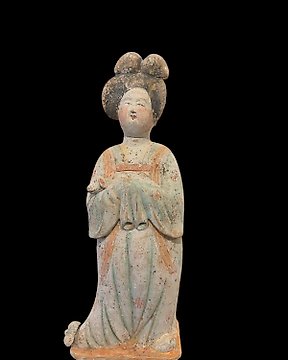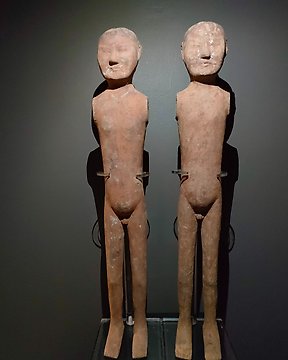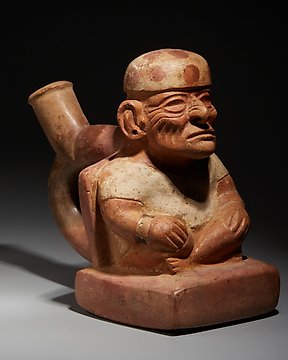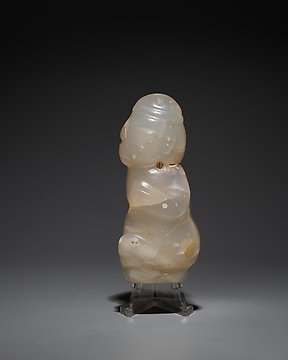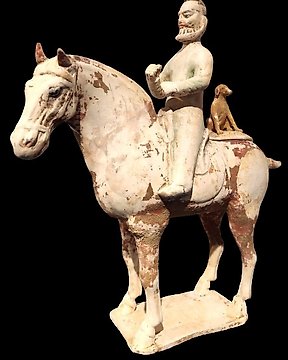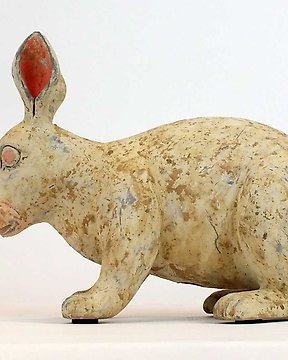Received my parcel in great condition. Very well taken care of. Thank you!
Ver traducciónChino antiguo Terracota Fat Lady with TL Test. Huge - - 55.5 cm
N.º 85166077
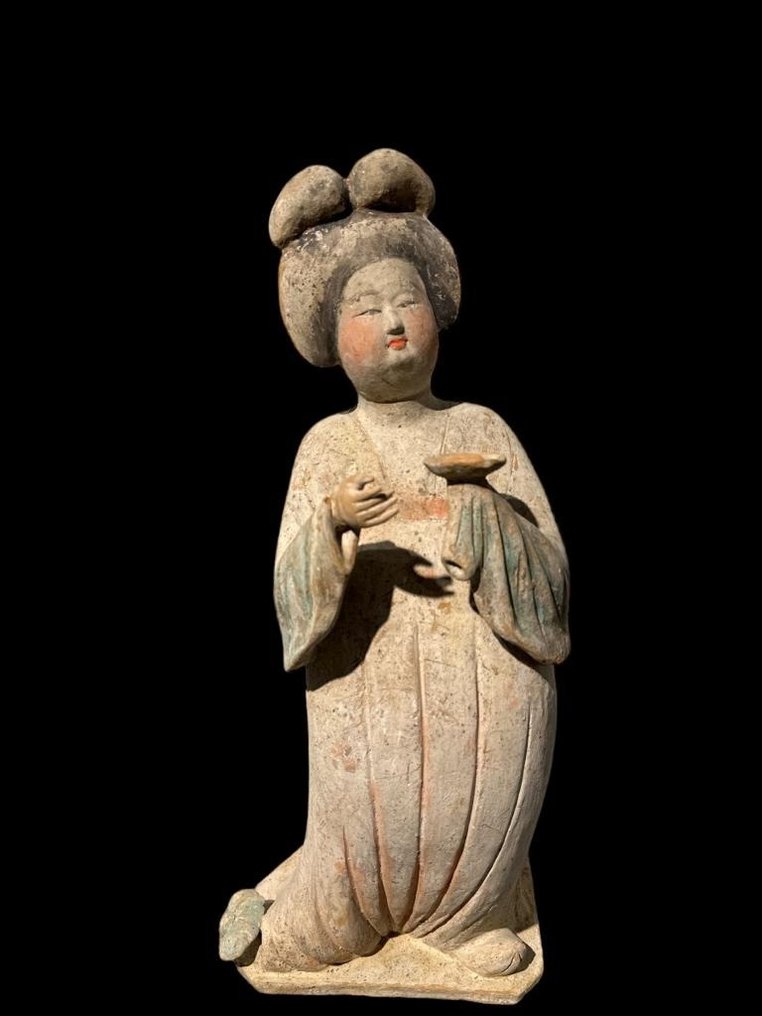

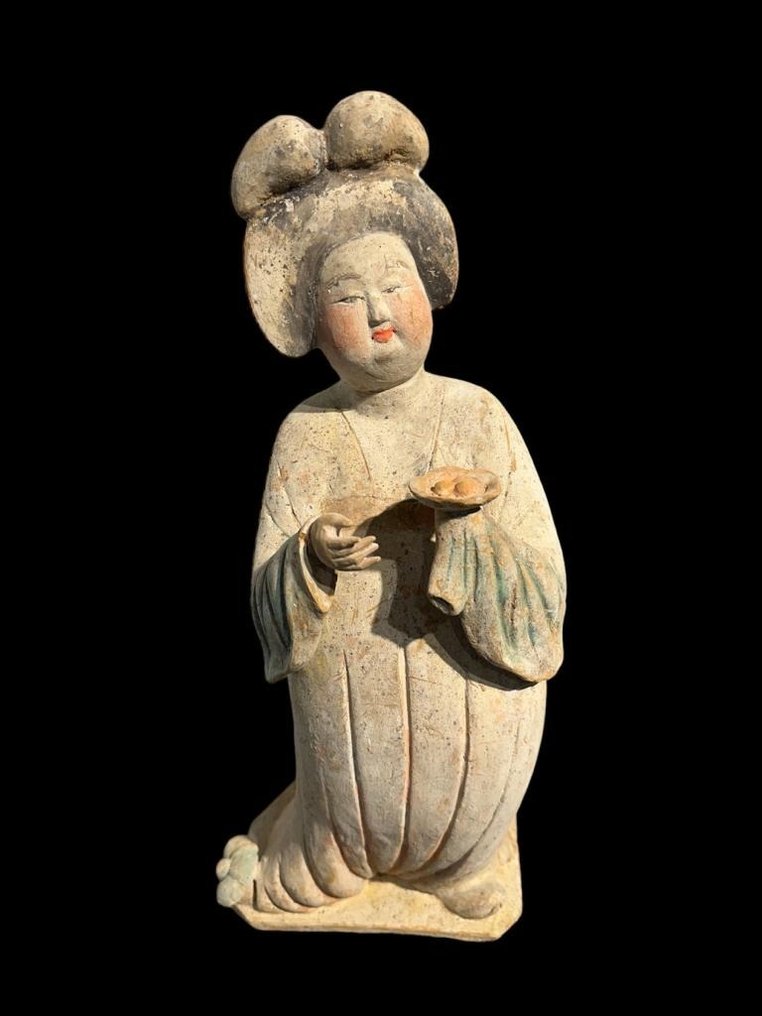
Ladies of the court, attired in a complex hairstyle with their hair tied back and richly dressed, in green, light brown tunics and white flowers. Clothes decorated with floral motifs. Terracotta decorated with cold applied slips. The figure stands out for its large size. good condition
The rise of the Fat Lady as a popular image of Chinese identity first appeared under the Zhou dynasty, which briefly interrupted the Tang dynasty. Women were idealized and heroized. The most famous court lady, Yang Guifei, the consort of Emperor Xuanzong (712-756), is said to have greatly shaped the fashion for ladies. Clothing and fashion were tailored to Yang's more mature figure, and for the first time long, flowing robes with high necklines became court fashion accompanied by elaborate hairstyles. One particular hairstyle is often seen in the sculptures of the Fat Ladies, made famous by the following story: One day, returning from a hunting trip, Yang fell off his horse and his high hairstyle fell off. On the one hand. If anything, the deliciously tousled state of her hair made her look even more beautiful. Not surprisingly, the other ladies of the palace were quick to copy her style, with her disheveled appearance. Yang's influence would last for generations.
Previously, the taste for women, especially concubines, had been oriented towards the slender woman. The new fashion of the Tang dynasty preferred the plumper figure. The plump women of the supreme court were enjoying their heyday. They were depicted in art and poetry and became popular in the royal household.
The typical Fat Ladies Tang style is characterized by its broad shape that is clearly displayed with rounded, rosy cheeks and a curved stomach. They have a mature, demure and graceful figure. Her hands are delicately placed, resting in front of her stomach or raised in different styles. Her locks often resemble the boundless nature described in Yang's story, freed from her limitations due to her escapade on horseback.
The piece includes Thermoluminescence Test. QED LABORATOIRE- FRANCE
Status: Earthy deposits on the surface. Restoration in hand.
Provenance: Private Collection M. L. F., 2021, Madrid. Purchased from an antique dealer in Hong Kong.
Notes: The piece includes a Spanish Export License (Passport for the European Union), at the time of sale it is requested in the name of the buyer, the process takes one to two weeks. - If the piece is destined for outside the European Union, the substitution of the export permit will be requested. This procedure entails Fee expenses that the buyer must pay during the application process. This process can take 2 to 4 weeks. SHIPPED WITH INSURANCE
Important information. The seller guarantees that he is entitled to ship this lot.
The seller will take care that any necessary permits will be arranged.
The seller will inform the buyer about this if this takes more than a few days.
#MostWantedEmpires
El vendedor y su historia
Ladies of the court, attired in a complex hairstyle with their hair tied back and richly dressed, in green, light brown tunics and white flowers. Clothes decorated with floral motifs. Terracotta decorated with cold applied slips. The figure stands out for its large size. good condition
The rise of the Fat Lady as a popular image of Chinese identity first appeared under the Zhou dynasty, which briefly interrupted the Tang dynasty. Women were idealized and heroized. The most famous court lady, Yang Guifei, the consort of Emperor Xuanzong (712-756), is said to have greatly shaped the fashion for ladies. Clothing and fashion were tailored to Yang's more mature figure, and for the first time long, flowing robes with high necklines became court fashion accompanied by elaborate hairstyles. One particular hairstyle is often seen in the sculptures of the Fat Ladies, made famous by the following story: One day, returning from a hunting trip, Yang fell off his horse and his high hairstyle fell off. On the one hand. If anything, the deliciously tousled state of her hair made her look even more beautiful. Not surprisingly, the other ladies of the palace were quick to copy her style, with her disheveled appearance. Yang's influence would last for generations.
Previously, the taste for women, especially concubines, had been oriented towards the slender woman. The new fashion of the Tang dynasty preferred the plumper figure. The plump women of the supreme court were enjoying their heyday. They were depicted in art and poetry and became popular in the royal household.
The typical Fat Ladies Tang style is characterized by its broad shape that is clearly displayed with rounded, rosy cheeks and a curved stomach. They have a mature, demure and graceful figure. Her hands are delicately placed, resting in front of her stomach or raised in different styles. Her locks often resemble the boundless nature described in Yang's story, freed from her limitations due to her escapade on horseback.
The piece includes Thermoluminescence Test. QED LABORATOIRE- FRANCE
Status: Earthy deposits on the surface. Restoration in hand.
Provenance: Private Collection M. L. F., 2021, Madrid. Purchased from an antique dealer in Hong Kong.
Notes: The piece includes a Spanish Export License (Passport for the European Union), at the time of sale it is requested in the name of the buyer, the process takes one to two weeks. - If the piece is destined for outside the European Union, the substitution of the export permit will be requested. This procedure entails Fee expenses that the buyer must pay during the application process. This process can take 2 to 4 weeks. SHIPPED WITH INSURANCE
Important information. The seller guarantees that he is entitled to ship this lot.
The seller will take care that any necessary permits will be arranged.
The seller will inform the buyer about this if this takes more than a few days.
#MostWantedEmpires
El vendedor y su historia
- 2
- 1
- 0
Très bel objet, livré dans l'appartement, parfait
Ver traducciónA embalagem era desadequada porque não garantiu a preservação da peça. Verficou-se a quebra de uma parte da peça.
Ver traducción- 2
- 1
- 0
Received my parcel in great condition. Very well taken care of. Thank you!
Ver traducciónAviso legal
El vendedor garantiza y puede probar que el objeto ha sido obtenido legalmente. Catawiki ha informado al vendedor de que tenía que proporcionar la documentación exigida por las leyes y reglamentos de su país de residencia. El vendedor garantiza que tiene derecho a vender/exportar este objeto. El vendedor le proporcionará al comprador toda la información disponible sobre la procedencia del objeto. El vendedor garantiza que se tramitarán todos los permisos necesarios. El vendedor informará inmediatamente al comprador de cualquier retraso en la obtención de dichos permisos.
El vendedor garantiza y puede probar que el objeto ha sido obtenido legalmente. Catawiki ha informado al vendedor de que tenía que proporcionar la documentación exigida por las leyes y reglamentos de su país de residencia. El vendedor garantiza que tiene derecho a vender/exportar este objeto. El vendedor le proporcionará al comprador toda la información disponible sobre la procedencia del objeto. El vendedor garantiza que se tramitarán todos los permisos necesarios. El vendedor informará inmediatamente al comprador de cualquier retraso en la obtención de dichos permisos.

